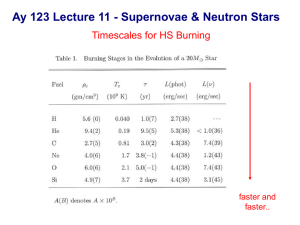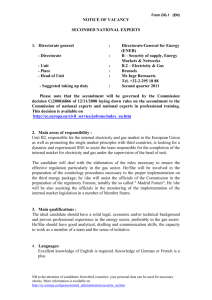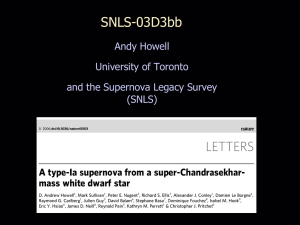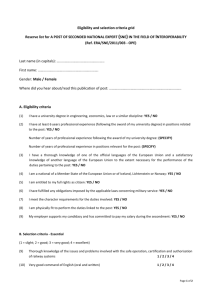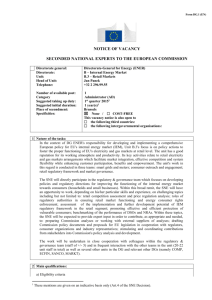Dark Energy Phenomenology a new parametrization Je-An Gu 顧哲安
advertisement
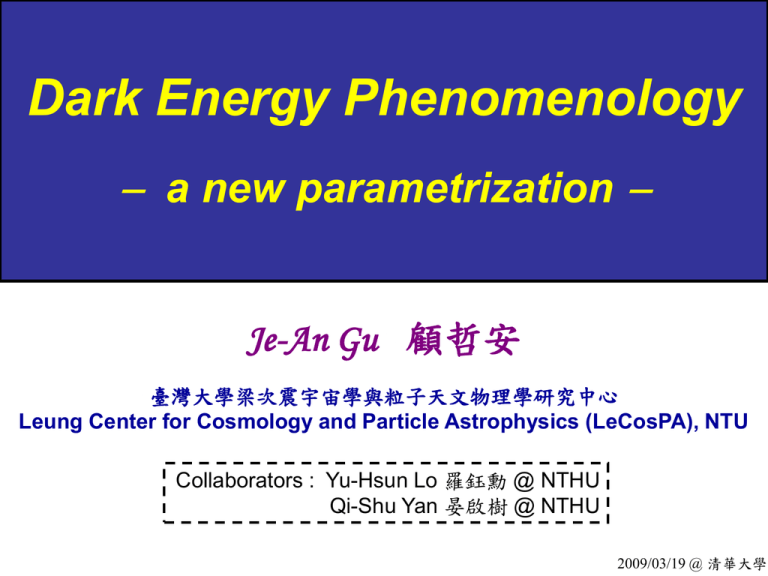
Dark Energy Phenomenology a new parametrization Je-An Gu 顧哲安 臺灣大學梁次震宇宙學與粒子天文物理學研究中心 Leung Center for Cosmology and Particle Astrophysics (LeCosPA), NTU Collaborators : Yu-Hsun Lo 羅鈺勳 @ NTHU Qi-Shu Yan 晏啟樹 @ NTHU 2009/03/19 @ 清華大學 CONTENTS Introduction (basics, SN, SNAP) Supernova Data Analysis — Parametrization A New (model-indep) Parametrization by Gu, Lo and Yan Test and Results Summary Introduction (Basic Knowledge, SN, SNAP) Concordance: = 0.73 , M = 0.27 Accelerating Expansion Based on FLRW Cosmology (homogeneous & isotropic) absolute magnitude M luminosity distance dL F L 4 d L2 F: flux (energy/areatime) L: luminosity (energy/time) SN Ia Data: dL(z) [ i.e, dL,i(zi) ] distance modulus 5 log10 (dL / 10pc ) redshift z from Supernova Cosmology Project: http://www-supernova.lbl.gov/ 1998 Distance Modulus mM m( z ) m( z ) m ( z ) fiducial model m M 5 log10 (dL / Mpc ) 25 0.7, m 0.3 SCP (Perlmutter et. al.) (can hardly distinguish different models) 2006 Riess et al., ApJ 659, 98 (2007) [astro-ph/0611572] 5 log10 (dL / 10pc ) Supernova / Acceleration Probe (SNAP) observe ~2000 SNe in 2 years (2366 in our analysis) statistical uncertainty mag = 0.15 mag 7% uncertainty in dL sys = 0.02 mag at z =1.5 z = 0.002 mag (negligible) z 0~0.2 0.2~1.2 1.2~1.4 1.4~1.7 # of SN 50 1800 50 15 Models: Dark Geometry vs. Dark Energy Einstein Equations Gμν = Geometry Matter/Energy ↑ Dark Geometry 8πGNTμν ↑ Dark Matter / Energy • Modification of Gravity • (from vacuum energy) • Extra Dimensions • Quintessence/Phantom • Averaging Einstein Equations for an inhomogeneous universe (Non-FLRW) (based on FLRW) Supernova Data Analysis — Parametrization / Fitting Formula — Data vs. Models Observations Data mapping out the evolution history (e.g. SNe Ia , BAO) Models Theories Data Analysis (e.g. 2 fitting) M1 M2 M3 : Quintessence : a dynamical scalar field : M1 (tracker quint., exponential) V VA exp A1 M constraint s on parameters : VA , A1, M,0 ,0 M2 (tracker quint., power-law) n V m 4n A2 constraint s on parameters : n, A2 , m,0 ,0 Reality : Many models survive Observations Data mapping out the evolution history (e.g. SNe Ia , BAO) Models Theories Data Analysis (e.g. 2 fitting) Data Shortages: – Tedious. – Distinguish between models ?? – Reality: many models survive. M1 (O) M2 (O) M3 (X) M4 (X) M5 (O) M6 (O) : : : : : : Dark Energy info NOT clear. Reality : Many models survive Instead of comparing models and data (thereby ruling out models), Extract information about dark energy directly from data by invoking model independent parametrizations. Model-independent Analysis Data Dark Energy Information Constraints on Parameters analyzed by invoking Parametrization Fitting Formula in wa 1 0 Riess et al. ApJ, 2007 Example [e.g. wDE(z), DE(z)] wDE(z) -0.5 -1 -1.5 -1 Linder, PRL, 2003 z w0 w DE ( z ) w 0 w a (1 a ) w 0 w a z 1 z wDE ( z ) w 0 w1z w1 DE (z) DE (0) Wang & Mukherjee ApJ 650, 2006 w0 w : equation of state, an important quantity characterizing the nature of an energy content. It corresponds to how fast the energy density changes along with the expansion. Answering questions about Dark Energy Instead of comparing models and data (thereby ruling out models), Extract information about dark energy directly from data by invoking model independent parametrizations, thereby answering essential questions about dark energy. Issue ? How to choose the parametrization ? Linder, PRL, 2003 : wDE (z) w 0 w a (1 a) w 0 w a z 1 z Taylor expansion : wDE (z) w 0 w1z “standard parametrization” ? A New Parametrization (proposed by Gu, Lo, and Yan) New Parametrization by Gu, Lo & Yan SN Ia Data: dL(z) [ i.e, dL,i(zi) (and errors) ] For a supernova located at r (t emit ) when it emitted photons (at time t emit ) that we observe today, a0 1 z , a0 a(t 0 ) , t 0 : present time a(t emit ) z dz a 1 da ( H : Hubble expansion rate ) a0 r ( z ) c , H 0 H ( z ) a a dt z dz d L ( z ) a0 r ( z ) 1 z c 1 z 0 H ( z ) Assume flat universe. 3H02 8G 2 2 total ( z ) H (z) total ( z ) H0 , c 3 c 8G total ( z ) m ( z ) r ( z ) x ( z ) “m”: NR matter – DM & baryons “r”: radiation “x”: dark energy dz z m (0)1 z r (0)1 z x (0) exp 3 1 w x ( z ) 0 1 z 3 4 New Parametrization by Gu, Lo & Yan Separate x ( z ) into 2 parts : x ( z ) w ( z ) x ( z ) 0 0 (i) w 0 ( z ) x (0)1 z i.e., the energy density of an energy source with a constant equation of state w 0 w x (0) and w 0 (0) x (0) 3 1w (ii) x ( z ) : the correction /differenc e w0 (0) x (0) x (0) 0 total ( z ) m ( z ) r ( z ) w ( z ) x ( z ) 0 x ( z ) (z) m ( z ) r ( z ) w ( z ) 0 3 1w x ( z ) w ( z ) x ( z ) x (0)1 z m ( z ) r ( z ) w ( z ) m ( z ) r ( z ) x (0)1 z 31w 0 0 0 total ( z ) m ( z ) r ( z ) w ( z ) 1 ( z ) 0 The density fraction (z) is the very quantity to parametrize. [ instead of x(z) or wx(z) ] 0 New Parametrization by Gu, Lo & Yan General Features x (0) 0 (0) 0 ( z ) 1 in most cases ( z ) 1 in earlier times ( z ) 0 as z (0 ) 0 Boundary conditions for ( z ) : () 0 z tan 4 (change of variable) 0 z 0 2 (0 ) 0 Boundary conditions for ( ) : (2 ) 0 1 Invoke Fourier series : ( ) A0 An cos n Bn sin n 2 n 1 n 1 New Parametrization by Gu, Lo & Yan 1 Invoke Fourier series : ( ) A0 An cos n Bn sin n 2 n 1 n 1 1 Boundary Condition A0 An 0 2 n 1 w 0 w x (0 ) nB n 1 n 0 The lowest-order nontrivial parametrization: A 1 is required for guaranteei ng x (z) 0 New Parametrization by Gu, Lo & Yan total (z) H(z) dL (z) [cf. Data] m ( z ) m (0)1 z 4 r ( z ) r (0)1 z 3 1w w ( z ) x (0)1 z 3 total ( z ) m ( z ) r ( z ) x ( z ) m ( z ) r ( z ) w ( z ) x ( z ) m ( z ) r ( z ) w ( z ) 1 ( z ) 0 0 i.e., 0 ( z ) 4 Az 2 0 1 z 2 2 i i (0) c total ( z ) 4 Az 2 3 4 3 1w 1 ( 0 ) 1 z ( 0 ) 1 z ( 0 ) 1 z m r x 2 2 c 1 z parameters : m, r , x ,w 0 , A In our analysis, we set 0 w0 : present value of DE EoS A “amplitude” of the correction x(z) m 0.27, r 0, x 1 m 0.73 2 parameters: w0 , A New Parametrization by Gu, Lo & Yan m ( z ) m (0)1 z 4 r ( z ) r (0)1 z 3 1w w ( z ) x (0)1 z x ( z ) w ( z ) 4 Az 2 (z) m ( z ) r ( z ) w ( z ) 1 z 2 2 3 0 0 For the present epoch, ignore r(z). 0 4 Az 2 m (0) 3w 0 x ( z ) w 0 ( z ) x ( z ) x (0)1 z 1 1 1 z 2 2 ( 0 ) 1 z x 2 m (0 ) 3 1 3 1 w z 4 A 1 1 w 2 3 w z 1 0 0 0 z , x (z) x (0 ) 2 x (0) 31w 0 (0 ) z 4A m z , z 1 x (0 ) 3 1w 0 Linder w x ( z ) w 0 w a 1 a w 0 w a x ( z ) x (0)1 z 3 1w 0 w a z 1 z e 3w a z 1 z x ( z ) 1 31 w 0 z 2 5w 0 3w 02 w a z 2 , z 1 2 x (0) z 31w w e 3w , z 1 3 0 a a 0 Test and Results Procedures of Testing Parametrizations Background cosmology [pick a DE Model with wDEth(z)] generate Data w.r.t. present or future observations (Monte Carlo simulation) employ a Fit to the dL(z) or w(z) reconstruct wDEexp’t (z) compare wDEexp’t and wDEth Gu, Lo & Yan 192 SNe Ia : real data and simulated data w x 1.4,1.2,1.0,0.8,0.6 w x 0.2 1 Info1 : Black vs. Blue(s) overlap consistency Info2 : Blue vs. Blue no overlap distinguishable A real w x 1.4 1 0.6 from 192 SNe Ia w0 Gu, Lo & Yan 192 SNe Ia : real data and simulated data w x 1.4,1.2,1.0,0.8,0.6 w x 0.2 real A w x 1.4 1 from 192 SNe Ia Info1 : Black vs. Blue(s) Info2 : Blue vs. Blue w0 0.6 2 Gu, Lo & Yan 192 SNe Ia : real data and simulated data w x 1.4,1.2,1.0,0.8,0.6 w x 0.2 real A w x 1.4 1 from 192 SNe Ia Info1 : Black vs. Blue(s) Info2 : Blue vs. Blue w0 0.6 3 Linder 192 SNe Ia : real data and simulated data w x 1.4,1.2,1.0,0.8,0.6 w x 0.2 from 192 SNe Ia real wa 0.6 w x 1.4 Info1 : Black vs. Blue(s) Info2 : Blue vs. Blue 1 w0 1 Linder 192 SNe Ia : real data and simulated data w x 1.4,1.2,1.0,0.8,0.6 w x 0.2 real from 192 SNe Ia wa 0.6 1 w x 1.4 Info1 : Black vs. Blue(s) Info2 : Blue vs. Blue w0 2 Linder 192 SNe Ia : real data and simulated data real w x 1.4,1.2,1.0,0.8,0.6 w x 0.2 from 192 SNe Ia wa 0.6 1 w x 1.4 Info1 : Black vs. Blue(s) Info2 : Blue vs. Blue w0 3 From 192 SNe Ia Gu, Lo & Yan Linder w x 1.4,1.2,1.0,0.8,0.6 w x 0.2 1 1 real real A wa w x 1.4 1 0.6 w0 Info1 : Black vs. Blue(s) Info2 : Blue vs. Blue w0 From 192 SNe Ia Gu, Lo & Yan Linder w x 1.4,1.2,1.0,0.8,0.6 w x 0.2 2 2 real real A wa w x 1.4 w0 1 0.6 Info1 : Black vs. Blue(s) Info2 : Blue vs. Blue w0 From 192 SNe Ia Gu, Lo & Yan Linder w x 1.4,1.2,1.0,0.8,0.6 w x 0.2 3 real 3 real A wa w x 1.4 w0 1 0.6 Info1 : Black vs. Blue(s) Info2 : Blue vs. Blue w0 w x 1.20,1.15,1.10,1.05,1.00,0.95,0.90,0.85,0.80 Gu, Lo & Yan w x 0.05 from 192 SNe Ia simulated 1 real simulated data data Info1 : Blue vs. White(s) overlap consistency real w x 1.20,1.15,1.10,1.05,1.00,0.95,0.90,0.85,0.80 Linder w x 0.05 from 192 SNe Ia 1 simulated real simulated data data Info1 : Blue vs. White(s) overlap consistency real Gu, Lo & Yan 2366 simulated SNe vs. 192 real SNe w x 1.4,1.3,1.2,1.1,1.0,0.9,0.8,0.7,0.6 w x 0.1 from 192 real SNe Ia A from 2366 simulated SNe Ia w x 1.4 w0 1 0.6 1 Linder 2366 simulated SNe vs. 192 real SNe w x 1.4,1.3,1.2,1.1,1.0,0.9,0.8,0.7,0.6 w x 0.1 from 192 real SNe Ia wa from 2366 simulated SNe Ia w x 1.4 w0 1 0.6 1 Gu, Lo & Yan 2366 Simulated SN Ia Data w x 1.40,1.35,1.30,,1.00,,0.65,0.60 w x 0.05 A w x 1.4 1 0.6 from 2366 simulated SNe Ia Info from comparing nearby contours w0 1 Gu, Lo & Yan 2366 Simulated SN Ia Data w x 1.40,1.35,1.30,,1.00,,0.65,0.60 w x 0.05 A w x 1.4 1 0.6 from 2366 simulated SNe Ia Info from comparing nearby contours w0 2 Gu, Lo & Yan 2366 Simulated SN Ia Data w x 1.40,1.35,1.30,,1.00,,0.65,0.60 w x 0.05 A w x 1.4 1 0.6 from 2366 simulated SNe Ia Info from comparing nearby contours w0 3 Gu, Lo & Yan 2366 Simulated SN Ia Data w x 1.40,1.35,1.30,,1.00,,0.65,0.60 w x 0.05 A w x 1.4 1 0.6 from 2366 simulated SNe Ia Info from comparing nearby contours w0 4 Gu, Lo & Yan 2366 Simulated SN Ia Data w x 1.40,1.35,1.30,,1.00,,0.65,0.60 w x 0.05 A w x 1.4 1 0.6 from 2366 simulated SNe Ia Info from comparing nearby contours w0 5 Linder 2366 Simulated SN Ia Data w x 1.40,1.35,1.30,,1.00,,0.65,0.60 w x 0.05 wa w x 1.4 1 0.6 from 2366 simulated SNe Ia Info from comparing nearby contours w0 1 Linder 2366 Simulated SN Ia Data w x 1.40,1.35,1.30,,1.00,,0.65,0.60 w x 0.05 wa w x 1.4 1 0.6 from 2366 simulated SNe Ia Info from comparing nearby contours w0 2 Linder 2366 Simulated SN Ia Data w x 1.40,1.35,1.30,,1.00,,0.65,0.60 w x 0.05 wa 1 0.6 w x 1.4 from 2366 simulated SNe Ia Info from comparing nearby contours w0 3 Linder 2366 Simulated SN Ia Data w x 1.40,1.35,1.30,,1.00,,0.65,0.60 w x 0.05 wa 0.6 1 w x 1.4 from 2366 simulated SNe Ia Info from comparing nearby contours w0 4 Linder 2366 Simulated SN Ia Data w x 1.40,1.35,1.30,,1.00,,0.65,0.60 w x 0.05 wa 0.6 1 w x 1.4 from 2366 simulated SNe Ia Info from comparing nearby contours w0 5 Summary Summary A parametrization (by utilizing Fourier series) is proposed. This parametrization is particularly reasonable and controllable. It is systematical to include more terms and more parameters. Via this parametrization: The current SN Ia data, including 192 SNe, can distinguish between constant-wx models with wx = 0.2 at 1 confidence level. The future SN Ia data, if including 2366 SNe, can distinguish between constant-wx models with wx = 0.05 at 3 confidence level, and the models with wx = 0.1 at 5 confidence level Thank you. Supernova (SN) : mapping out the evolution herstory Type Ia Supernova (SN Ia) : history (standard candle) – thermonulear explosion of carbon-oxide white dwarfs – Correlation between the peak luminosity and the decline rate absolute magnitude M luminosity distance dL F L 4 d 2 L F: flux (energy/areatime) L: luminosity (energy/time) (distance precision: mag = 0.15 mag dL/dL ~ 7%) F 100 m / 5 Spectral information redshift z SN Ia Data: dL(z) [ i.e, dL,i(zi) ] (z) M m10 pc [ ~ x(t) ~ position (time) ] Distance Modulus mM m M 5 log10 (dL / Mpc ) 25 2004 Fig.4 in astro-ph/0402512 [Riess et al., ApJ 607 (2004) 665] Gold Sample (data set) [MLCS2k2 SN Ia Hubble diagram] - Diamonds: ground based discoveries - Filled symbols: HST-discovered SNe Ia - Dashed line: best fit for a flat cosmology: M=0.29 =0.71 2006 Riess et al., ApJ 659, 98 (2007) [astro-ph/0611572] OK, if few models survive. Observations Data mapping out the evolution history (e.g. SNe Ia , BAO) Models Theories Data Analysis (e.g. 2 fitting) Data Tedious work, worthwhile if few models survive, and accordingly clear Dark Energy info obtained. : : : M1 M2 M3 M4 M5 M6 : : : (X) (X) (O) (X) (X) (X)

